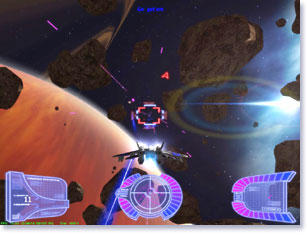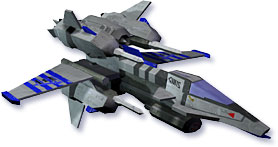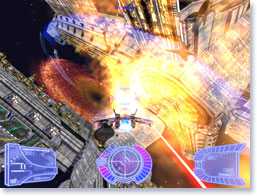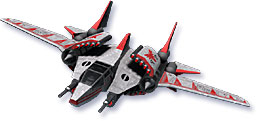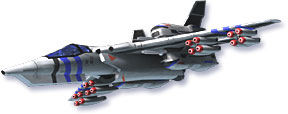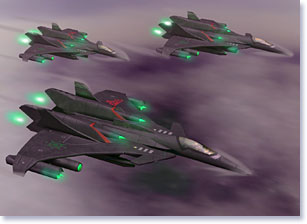Reactor Interactive have been using Caligari products in the development of their game Sector 13 since they were first formed. Below you can hear their experiences about and advice on making a game as an indie developer.
Tell us a bit about Reactor Interactive?
| It began back in 1997 when I started a company called “Paladin Studios” with some friends that I worked with. We wanted to make games, we started some projects, but very typically our focus was all over the map, so nothing ever came close to getting done!
When I finally decided to go back to college full-time, I was sought out by a group of guys who wanted to make a game. They had heard that I had done something similar in the past, and that I was at school to get a degree in multi-media technology management, which I hoped to use to start a career in game development. This was a group of five guys with a very typical first-time idea – massive in scope and |
far too ambitious to be done by amateurs in their spare time! The original idea was a go-anywhere, do-anything type game in the vein of Freelancer, with a very epic storyline and some pretty cool characters. While a good idea, and something I hope we do still get to do someday, the first thing I told them was that they needed to temper their ambition and focus. That was how Sector 13 was “born”. We decided to focus on our space flight engine and fighter combat system only.
Ryan moved out to where I lived and we began to work on Sector 13 in earnest. About that time, we decided to make the switch to an existing engine, rather than continue to try and write our own (which in hind-sight might not have been the best decision now that XNA is on the horizon – more about that later) and to get ourselves a complete team again. So we switched to the Ogre engine, and recruited the best group of guys I’ve had the privilege of working with. After two more years now, we are really close to completing something that we are really, truly proud of, and can’t wait to unleash on an unsuspecting gaming public!
How did you settle on the idea for Sector 13?
| Sector 13 was originally part of a complete action/adventure game engine. However we chose to focus on the space flight and combat model, with the plan to eventually build onto it until we had a much more epic and ambitious game. After a while though, we realized just how much fun it was when you boiled a game like this down to its basic elements, and decided that this was in fact the final game design.
We wanted a fast-paced, arcade-like multiplayer space shooter that focused on the action. Though we loved games like Freelancer, Descent Freespace and the X-Wing games, we wanted to stay away from the simulator and resource management approach. We wanted a game that you could play on a LAN between |
classes with friends for 20 minutes, blowing each other up and having some fun without any sort of long-term monetary or resource gathering, upgrades, etc.
I like to compare it to a fighting game, such as Soul Calibur or Virtua Fighter. All the characters are balanced and have an equal chance of winning in the right player’s hands, and you just choose the one you like the best due to looks, or attributes, style, etc.
So, the starfighters in Sector 13 kind of became our “characters”. We have a collection of starfighters in Sector 13 that are balanced and appeal to different players for different reasons, making skill and experience the heart of the game, rather than putting hours into the game to buy upgrades.
We realized some customization aspects were needed, which led to our hard point weapon system. We also wrote a whole set of editors and tools and other elements that we hope will make this a unique experience compared to what’s out there on the market right now.
What has been the hardest part in making Sector 13?
don’t expect anyone “in the industry” to take us seriously until we’ve accomplished something. We understand the risks involved with an indie team, and how hard it is to actually stand out in the market, and we have a plan to address all of it, but for now, our focus is just on having something “done” and marketable to prove the soundness of our concept.
What are your thoughts on recent options for an indie developer to get a game published, such as WiiWare, Xbox Live with XNA, Steam, etc?
Right now, XNA has me really excited. If it ends up being everything Microsoft says it is, it could be the best and most accessible option for an indie to get a game onto multiple platforms, including a console, without doing a rewrite or port. I hope to take advantage of XNA with Sector 13 sometime in the near future.
For distribution methods, Xbox Live Arcade is also something that I feel has amazing potential. I hope to get Sector 13 onto XBLA soon as we can. It seems like such a great way to get the game in front of lots of gamers with huge potential for expanding content and growing the game beyond just a casual title.
| Other services we’ve looked into have some very prohibitive fees and profit percentages compared to XBLA, but I think a lot of other companies are seeing how well Microsoft is using the Live Arcade service and trying to follow suit. We’ve seen some companies in the PC realm trying to pick this ball up and run with it, and we are pursuing some partnerships to make sure Sector 13 gets into the hands of as many gamers as possible when it’s ready. |
What aspect of Sector 13 are you most proud of?
Honestly, of all the things I love about Sector 13, the thing I’m the most proud of, is my team. They are so dedicated and talented and have given so much of their time and dedication to this vision, and I know that the only reason Sector 13 is something to be proud of is because of their hard work.
What advice would you give to those just starting out in making their own game?
This is a tough one! There’s so much that I’ve learned along the way, it’s hard to narrow down. I’d say, the number one thing is, be realistic. Don’t try to make the next million-player MMO for your first project. Don’t expect to put a demo together in three months and have publishers knocking on your door. Don’t think that a group of a dozen guys in their spare time will make a game that can compete with games that have millions of dollars in the budget and a team of experienced full-time developers.
The key to indie gaming is to find a genre or even a specific game-type that you know has an audience, but is being neglected by the mainstream. Then, know your audience, know what they want from a game like this, have a clear vision of what you’re trying to accomplish, and then have a design that you know you can complete in a realistic timeframe.
I’ve been working on Sector 13 for six years now, and of course I never intended for it to take this long. Only now, after years of development, are we truly ready to create a serious commercial version of the game that we can honestly say has a chance in the current market. It takes time, and you won’t know everything you’ll need to know on your first try. Just have fun and remember why you love games and what drew you to wanting to create games.
What tools do Reactor Interactive use?
On the art-side of things, we have fairly complicated pipeline; more complicated than I’d like! I use Caligari products myself of course. My art team uses everything from Maya to Blender to create models, which then will be UV’d by another artist, which then goes to another artist for texturing, which then goes to me or another artist for clean-up, rigging of bones and exporting. We have art programs that are just used as middleware to get objects into a format that other programs can use!
For example, a UV’d model created in Maya will be sent as an .obj for texturing to our 2D artists. That model is then sent to me to be loaded into gameSpace for some clean-up and exporting out to Milkshape. In Milkshape, I’ll rig bones and joints to designate things like where engine glows go, gun and missile fire points, and other points of interest that are generated by the engine. Then, Milkshape will export out to an Ogre mesh/skeleton format, which we then have to run an Ogre command-line tool on to create a special bones file that the engine actually uses. That model is then ready to be put in-game. I wish it was much simpler, but for now, that’s how we have to do it!
What does the future hold for Sector 13, and for Reactor Interactive?
| My only plan right now is to finish this first version. In indie gaming, it’s very dangerous to get too far ahead of yourself. We’ve already pitched Sector 13 in its incomplete form to several publishers and distributors, and based on the feedback we received it’s clear that this industry is all about reducing risk. A completed title with an established growing audience is far less risky than an incomplete game. |
I have a plan to work around that, though things change so quickly that the plan has to stay fairly general! My goals though are to be on XBLA as a minimum, but I have true triple-A aspirations for Sector 13, but that will take several iterations, expansions, and some lucky breaks to get there.
I and other team members have had several job offers in the industry thanks to Sector 13. None of us have taken any of them up though, and I know that in my case, it’s directly due to my belief of what Sector 13 can be.
What has been the biggest benefit for you in using Caligari software?
For me, I love Caligari software because of how easy it is for me to use and how quickly it lets me get an idea from my head and into a tangible form. Some of the apps I’ve worked with look like they were made by programmers, for programmers, and not intuitive for an artist. Blender, for example, is an application that I absolutely despise due to its clunky, unintuitive and very programmer-like interface. To me, it’s not an art tool, but a technical tool for creating art.
gameSpace, on the other hand, when I’m using it, it feels very similar to picking up my pencil and sketching in my sketch pad. Often, I skip the sketch pad altogether and just get into the software and start modeling, since it’s almost as easy to get my ideas down in the application as it would be to get them down on paper. I love this aspect of Caligari’s software vs. many of the other 3D apps I’ve used.
What are the most exciting changes in the field of game development that you see coming up in the next year?
get their game in front of their target audience and have a chance of making some money to keep the development going. I see companies starting to realize that they can make some great money off making ideas easier to achieve, and that really gives me hope for the future of gaming.

